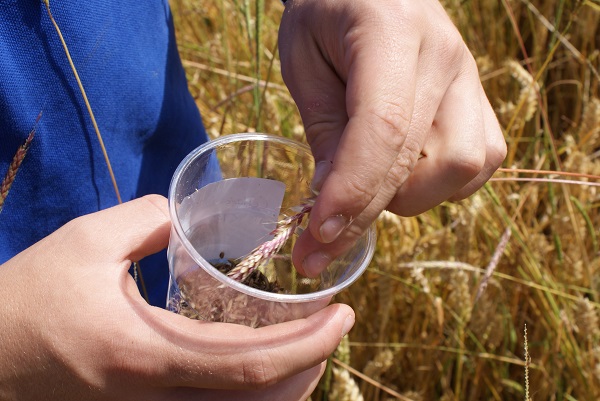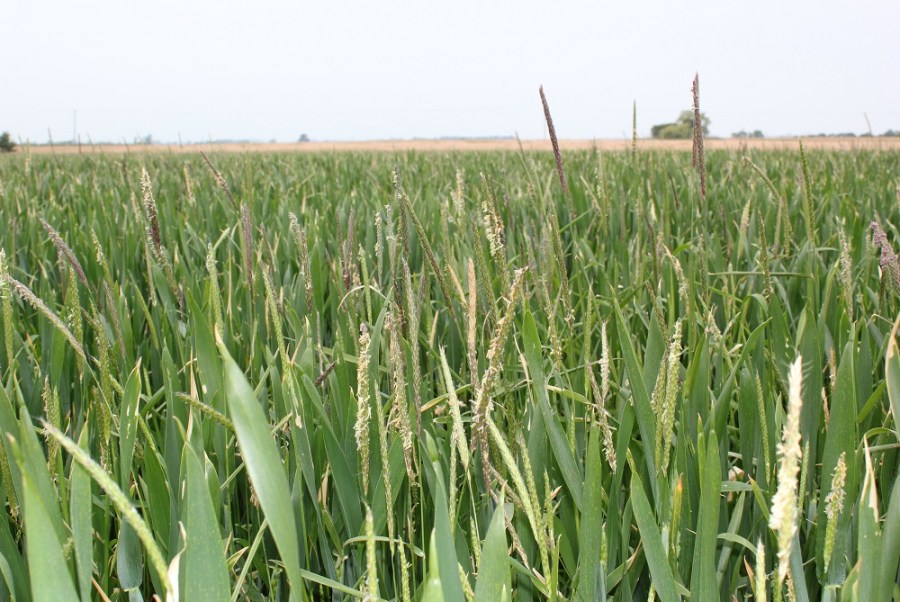Grassweeds waving their heads above cereal crops may be a reminder of how difficult they can be to control, but also present an opportunity to get to improve targeting in the future. CPM reports.
Weed seed heads provide the ideal opportunity to plan ahead and target management.
By Rob Jones
July is the most important month of the year for grassweed control, according to Roundup technical manager, Barrie Hunt who co-ordinates the national Grassweed Action management resource. And what’s more, it may involve absolutely no fieldwork, with the possible exception of pre-harvest oilseed rape spraying.

July is a good month to take samples of blackgrass to send for resistance testing.
In Barrie’s experience, July is a month that’s critical to the success of every element of the entire year’s cultural and chemical control programme.
“Fundamental to keeping on top of problem weeds like blackgrass, bromes and Italian ryegrass in the most sustainable way is knowing exactly what infestations you have and where they are,” he says.
“June and July are the only months when you can really tell this, especially in cereals where the distinctive weed heads stand out above the crop for all to see! It certainly isn’t comfortable having your agronomic failures on such public display.
“But unlike OSR, which can hide a multitude of sins beneath its canopy, weed seed heads above the cereal crop canopy provide the ideal opportunity to plan ahead and target management for the best and most cost-effective control,” he comments.
“We know that different weed species need different approaches but so do different levels of infestation – whether on a whole field or individual area basis.”
So what exactly does Barrie recommend? “Essentially it’s a matter of getting out into your cereal crops and doing two things – identifying the precise weed species present and mapping where they are,” he says.
Mapping the infestations is best done from the tractor cab because it gives you a far better field view, he suggests. Barrie believes accurate mapping of weed infestations is the only real way of monitoring how successful – or otherwise – your grassweed controls are.
“Not all fields will require the same intensity of grassweed management,” he reasons. “So traffic light coding each field every season on the basis of its weed risk means you can concentrate the most rigorous controls on the worst-affected ground, where they are most needed.
“Red-coded fields are almost certainly best ear-marked for rotational ploughing, delayed winter cereal sowing or spring cropping, together with the most robust pre-planting, pre-em and post-em herbicide programmes,” he says.
“On the other hand, fields with less pressing problems may be drilled earlier in the autumn and with less intensive pre and post-em herbicide programmes for valuable savings in both cost and hassle.
“The apparent absence of grassweeds in a single season should not automatically result in a green coding. Instead, it’s important to consider the history of each field in your planning.”
The accurate mapping of weed problems across individual fields has become infinitely more practical and valuable with the digital tools increasingly available to growers. This allows fields to be zoned and sprayed for their specific weed burdens – either using a precision agronomy service or manually – to concentrate the chemistry even more precisely to where it’s most needed for the greatest financial and environmental sustainability.
“Satellite, drone or ground-based imaging can be useful here in some cases. But there’s still a lot of ‘ifs’ and ‘buts’ with these technologies. So there really is nothing to beat getting out into your crops in July and recording exactly what’s going on. In my view, it remains the ‘number one’ essential to keeping your grassweed problems firmly under control.”
Equally important is accurately identifying the different weed species present in the field, adds Barrie.
“Most of us can distinguish blackgrass, brome and Italian ryegrass easily from the cab,” he notes. “But the five brome species can be difficult to tell apart, even once they’ve headed in the summer. The two main groups of bromes need quite different autumn cultivation and pre-planting control strategies, and the different species have different susceptibilities to post-em herbicides, so taking the time to carefully identify which species you have is essential.
“This is particularly important where you have mixed populations of weeds. With sterile or great brome on the headlands and blackgrass across the rest of the field, it will pay to shallow-till the entire area immediately behind the combine to establish a stale seedbed,” he says.
“If you have meadow, soft or rye brome on the headlands, it’s best to leave these areas for around a month before cultivating so you don’t induce dormancy,” he adds.
“With herbicide resistance a problem in both blackgrass and Italian ryegrass and suspected in brome, resistance testing every three to five years can also save a lot of unnecessary chemical expense. In which case, you’ll need to take a sample of ripe seed from across the field.”
Targeted action
Grassweed Action is a special on-line resource providing arable managers across the country with a structured approach to regaining control over their most damaging grassweeds based on the best available intelligence.
Developed with national weed authority, Dr Stephen Moss, it provides well-researched, practical frameworks for regaining control over blackgrass, Italian ryegrass, bromes, wild-oats and couch, that can be implemented by growers and their advisers in ways which best suit their own farm conditions and circumstances.
The free-to-use resource available at www.monsanto-ag.co.uk/grassweed-action includes a knowledge hub providing the best current understanding of each weed and a newsroom offering the latest control intelligence and advice.




